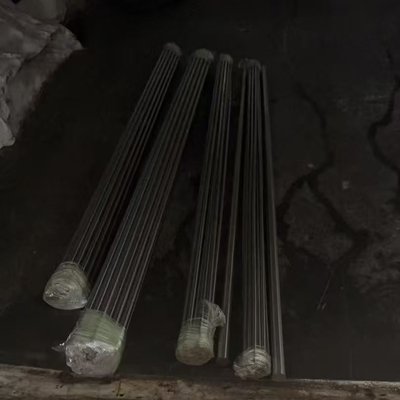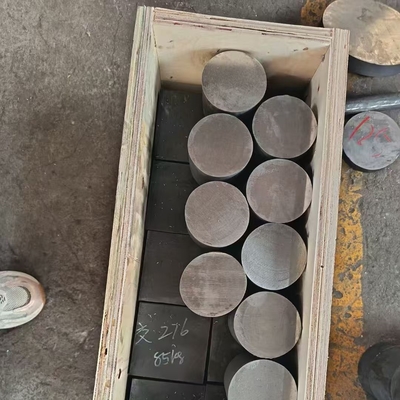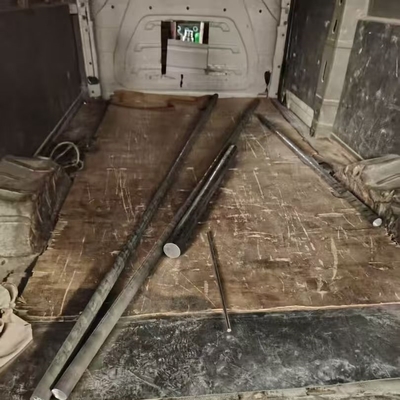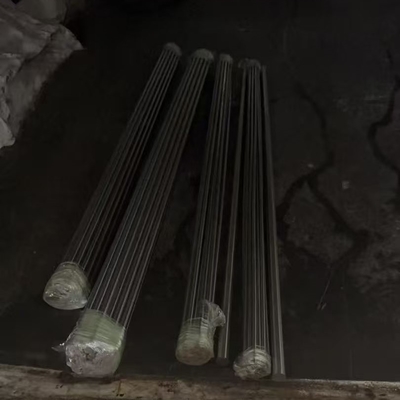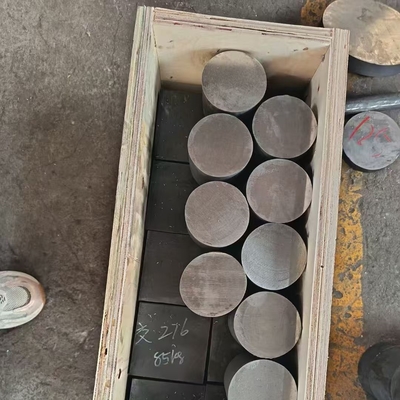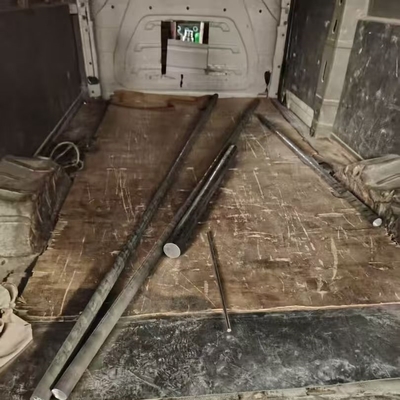-
Striscia di acciaio inossidabile
-
Strato di acciaio inossidabile
-
Piatto di acciaio inossidabile
-
tubo di acciaio inossidabile
-
Acciaio inossidabile Antivari
-
Bobina d'acciaio galvanizzata
-
Piatto d'acciaio
-
tondino d'acciaio
-
lega di nichel
-
Tubo d'acciaio senza cuciture
-
Fascio di acciaio inossidabile
-
Strato del piatto di rame
-
Tondino di rame
-
 Raian IonescuQualità materiale molto buona. abbiamo cooperare più di 10 anni. Vendono i generi dei lotti di materiale d'acciaio. Tutta la qualità materiale buona. Essi dovere per tutta la qualità materiale. Stiamo spianando per continuare a cooperare in futuro con loro
Raian IonescuQualità materiale molto buona. abbiamo cooperare più di 10 anni. Vendono i generi dei lotti di materiale d'acciaio. Tutta la qualità materiale buona. Essi dovere per tutta la qualità materiale. Stiamo spianando per continuare a cooperare in futuro con loro
Barra c276 laminata a caldo con lega a soluzione solida 2.4819 / UNS N10276 Standard ASTM EN DIN GB
| Luogo di origine | Cina |
|---|---|
| Marca | DELTA |
| Certificazione | ISO |
| Numero di modello | C276 / 2.4819 |
| Quantità di ordine minimo | 500 kg |
| Prezzo | 40.2-45 USD/Kg |
| Imballaggi particolari | imballaggio standard per l'esportazione |
| Tempi di consegna | 5 - 12 giorni in base alla quantità |
| Termini di pagamento | L/C, T/T, Western Union |
| Capacità di alimentazione | 3 tonnellate a settimana |

Contattimi gratis campioni e buoni.
Whatsapp:0086 18588475571
Wechat: 0086 18588475571
Skype: sales10@aixton.com
Se avete di preoccupazione, forniamo la guida in linea di 24 ore.
x| Prodotti | Placca in lega di nichel | Grado | c276 |
|---|---|---|---|
| Diametro | 6 - 350 mm | Lunghezza | taglio su misura di qualsiasi lunghezza su richiesta |
| Standard | Astm en | Servizio | Taglio |
| Porta di caricamento | Shanghai Port | Superficie | nero, luminoso |
| Evidenziare | Barra in lega di nichel C276 laminata a caldo,Barra in lega a soluzione solida 2.4819,Barra standard UNS N10276 ASTM |
||
c276 bar laminato a caldo con soluzione solida Lega 2.4819 / UNS N10276 ASTM EN DIN GB Standard
Maggiori informazioni sulle specifiche
| Nome dei prodotti | Hastelloy C276 barra rotonda / canna |
| Diametro | 6.0 - 350 mm |
| Distanze | taglio su misura di qualsiasi lunghezza su richiesta |
| Superficie | Nero, luminoso. |
| Marchio | DELTA |
| Servizio | Taglio, lucidatura |
| MOQ | 2 kg |
| Altri tipi | Barra rotonda, striscia, bobina, tubo, foglio, piastra, filo, ecc. |
| Imballaggio | carta impermeabile e pallet di legno, scatola di legno |
| Porto di carico | Porto di Shanghai |
| Termine del prezzo | EXW, FOB, CIF, CFR |
| Tempo di consegna | entro 12 giorni |
Diametro regolare di Hastelloy C276 Baronda in magazzino
| 6 mm | 8 mm | 9 mm | 10 mm | 12 mm | 14 mm |
| 15 mm | 16 mm | 18 mm | 19 mm | 20 mm | 22 mm |
| 25 mm | 28 mm | 30 mm | 32 mm | 35 mm | 38 mm |
| 40 mm | 42 mm | 45 mm | 48 mm | 50 mm | 55 mm |
| 60 mm | 65 mm | 70 mm | 75 mm | 80 mm | 85 mm |
| 90 mm | 95 mm | 100 mm | 105 mm | 110 mm | 115 mm |
| 120 mm | 125 mm | 130 mm | 140 mm | 150 mm | 160 mm |
| 170 mm | 180 mm | 190 mm | 200 mm | 210 mm | 220 mm |
| 230 mm | 240 mm | 250 mm | 260 mm | 270 mm | 280 mm |
| 290 mm | 300 mm | 310 mm | 320 mm | 330 mm | 340 mm |
C276 Bar laminata a caldo con soluzione solida Legatura 2.4819 / UNS N10276 ASTM EN DIN GB Standard
Riassunto
La Hastelloy C-276 (UNS N10276, W.Nr. 2.4819) è una lega di nichel-cromo-molibdeno rinomata per la sua eccezionale resistenza alla corrosione in ambienti difficili.Il presente documento tecnico fornisce una panoramica completa delle barre di lega C-276 laminate a caldo e trattate con soluzione solida, dettagliando la composizione chimica, le proprietà fisiche e meccaniche, le norme internazionali applicabili, le diverse applicazioni e le forme di prodotto disponibili.Le informazioni presentate servono da guida per gli ingegneri e i progettisti che selezionano materiali per applicazioni industriali aggressive in cui è richiesta la resistenza sia agli agenti ossidanti che a quelli riducenti..
1 Introduzione alla lega Hastelloy C-276
Hastelloy C-276, noto anche come UNS N10276 secondo il sistema di numerazione unificato e 2.4819 secondo il sistema di numerazione dei materiali W.Nr. (Werkstoffnummer),è una superlega a base di nichel appartenente alla famiglia di materiali Hastelloy sviluppata da Haynes InternationalQuesta lega è specificamente progettata per offrire un'eccezionale resistenza alla corrosione in ambienti industriali esigenti.Il grado C-276 contiene importanti aggiunte di molibdeno (15-17%) e cromo (14La presenza di tungsteno (34,5%) ne aumenta ulteriormente la resistenza alla corrosione.in particolare in ambienti a acido misto e in scenari di corrosione localizzati.
La lega è caratterizzata da un basso contenuto di carbonio (in genere ≤ 0,01%), che riduce al minimo le precipitazioni di carburo durante la saldatura e il trattamento termico,mantenendo così la resistenza alla corrosione nella condizione saldataQuesta combinazione di proprietà rende le barre di C-276 particolarmente adatte per la fabbricazione di componenti che devono resistere a mezzi chimici aggressivi, alte temperature,e ambienti di crepa per corrosione da sollecitazioneLe barre laminate a caldo in condizioni trattate con soluzione solida offrono proprietà meccaniche ottimali e uniformità microstrutturale per i successivi processi di lavorazione e fabbricazione.
2 Parametri e proprietà chiave
2.1 Composizione chimica
La composizione chimica dell'alloi Hastelloy C-276 è accuratamente bilanciata per raggiungere la sua rinomata resistenza alla corrosione mantenendo al contempo buone proprietà meccaniche e fabbricabilità.La tabella seguente presenta i requisiti chimici tipici per le barre in lega UNS N10276.:
* Tabella 1: Requisiti di composizione chimica per Hastelloy C-276 (UNS N10276) *
| Elemento | Contenuto (% in peso) | Ruolo nella lega |
|---|---|---|
| Nilo (Ni) | Saldo (52-60%) | Elemento di base che fornisce una matrice austenitica e una resistenza generale alla corrosione, in particolare in ambienti riducenti |
| Cromo (Cr) | 14.5 - 16.5 | Fornisce resistenza agli agenti ossidanti e all'ossidazione ad alta temperatura |
| Molibdeno (Mo) | 15.0 - 17.0 | Migliora la resistenza agli acidi riducenti (ad esempio, solforico, cloridrico) e alla corrosione da buche/fessure |
| Volframmo (W) | 3.0 - 4.5 | Migliora la resistenza agli acidi riducenti e alla corrosione localizzata; fornisce un rafforzamento della soluzione solida |
| Ferro (Fe) | 4.0 - 7.0 | Componente di bilanci e costo; controllato per mantenere la resistenza alla corrosione |
| Manganese (Mn) | ≤ 1.00 | Elemento residuo; aiuta la deossidazione durante la fusione |
| Silicio (Si) | ≤ 0.08 | Elemento residuo; mantenuto a basso livello per evitare la formazione di una fase dannosa |
| Carbonio (C) | ≤ 0,01 (tipicamente) | Tenuto estremamente basso per evitare la precipitazione di carburo e mantenere la resistenza alla corrosione nelle strutture saldate |
| Cobalto (Co) | ≤ 2.5 | Elemento residuo controllato |
| Vanadio (V) | ≤ 0.35 | Elemento residuo controllato |
| Fosforo (P) | ≤ 0.04 | Impurità controllata per evitare effetti dannosi sulle proprietà meccaniche e sulla resistenza alla corrosione |
| Sulfuro (S) | ≤ 0.03 | Impurità controllata per prevenire la cracking a caldo e mantenere la resistenza alla corrosione |
*Dati raccolti dalle norme ASTM B574/B575 e da molteplici fonti di riferimento16*
2.2 Proprietà fisiche
La lega Hastelloy C-276 presenta proprietà fisiche caratteristiche delle leghe a base di nichel, con elevata densità e moderata espansione termica.Queste proprietà sono considerazioni importanti per i calcoli di progettazione che coinvolgono il ciclo termico, considerazioni di peso e applicazioni elettriche/termiche:
* Tabella 2: Proprietà fisiche di Hastelloy C-276 Bar*
| Immobili | Valore | Condizioni/Nota |
|---|---|---|
| Densità | 80,89 g/cm3 (0,321 lb/in3) | A temperatura ambiente |
| Distanza di fusione | 1325 - 1370°C (2417 - 2498°F) | - |
| Calore specifico | 427 J/kg·K (0,102 Btu/lb·°F) | A 20°C |
| Conduttività termica | 10.1 W/m·K (70 Btu/ft·h·°F) | A 20°C |
| Coefficiente medio di espansione termica | 11.2 μm/m·K (6,2 μin/in·°F) | 20-100°C |
| Resistenza elettrica | 10,30 μΩ·m | A 20°C |
| Modulo di elasticità (tensione) | 205 GPa (30 × 106 psi) | A temperatura ambiente |
| Permeabilità magnetica | < 1,001 (tipicamente) | Altri prodotti per l'alimentazione umana |
Dati provenienti da fonti di riferimento e dalle specifiche dei materiali26
2.3 Proprietà meccaniche
Le barre di C-276 laminate a caldo in condizioni trattate con soluzione solida presentano una combinazione di elevata resistenza, buona duttilità e eccellente resistenza agli urti in un ampio intervallo di temperature.La seguente tabella riassume le caratteristiche meccaniche tipiche a temperatura ambiente:
* Tabella 3: Proprietà meccaniche tipiche di soluzione solida laminata a caldo trattata con C-276 Bar*
| Immobili | Valore tipico | Standard di prova |
|---|---|---|
| Resistenza alla trazione | ≥ 690 MPa (≥ 100 ksi) | ASTM E8 |
| Forza del rendimento (0,2% di compensazione) | ≥ 283 MPa (≥ 41 ksi) | ASTM E8 |
| Allungamento in 2 pollici (50,8 mm) | ≥ 40% | ASTM E8 |
| Riduzione della superficie | ≥ 50% (tipico) | ASTM E8 |
| Durezza (Rockwell B) | ≤ 100 HRB (tipico) | ASTM E18 |
| Resistenza all'impatto a V-notch | ≥ 120 J/cm2 (≥ 70 ft-lb) a temperatura ambiente | ASTM A370 |
Dati provenienti da fonti di riferimento e dalle specifiche dei materiali256
Le proprietà meccaniche del C-276 rimangono relativamente stabili a temperature elevate, con una resistenza mantenuta e resistenza all'ossidazione fino a circa 650 °C (1200 °F).L'esposizione prolungata a temperature comprese tra 650 e 1090 °C (1200-2000 °F) può causare la precipitazione di fasi intermetalliche che possono ridurre la robustezza e la resistenza alla corrosione.
2.4 Proprietà di resistenza alla corrosione
L'alloi C-276 presenta una resistenza alla corrosione eccezionale in una vasta gamma di mezzi aggressivi, che è il suo principale vantaggio rispetto agli acciai inossidabili convenzionali e a molte altre leghe di nichel:
-
Ambienti riducenti: eccellente resistenza all'acido solforico di varie concentrazioni, all'acido cloridrico, all'acido fosforico e ad altre sostanze chimiche riducenti a causa del suo elevato contenuto di molibdeno.
-
Ambienti ossidanti: Buona resistenza agli agenti ossidanti, tra cui acido nitrico, cloruro ferrico, cloruro di rame e soluzioni clorurate, a causa del suo contenuto di cromo.
-
Corrosione localizzata: resistenza eccezionale alla corrosione da buche e alla corrosione da fessure in ambienti contenenti cloruro,con un numero equivalente di resistenza al buco (PREN) tipicamente nell'intervallo 65-75.
-
Cracking da corrosione da stress (SCC): elevata resistenza alla cracking da corrosione da stress indotta da cloruro, che lo rende adatto per applicazioni di processo chimico esigenti.
-
Acidi misti: particolarmente utili in ambienti contenenti miscele di acidi ossidanti e riducenti in cui altri materiali potrebbero fallire rapidamente.
La lega è uno dei pochi materiali in grado di resistere a gas cloro umido, soluzioni di ipoclorite e ambienti di biossido di cloro16.Esso dimostra inoltre una resistenza eccezionale agli attacchi corrosivi di acidi organici quali acido formico e acido acetico, anche a temperature elevate e in presenza di impurità27.
3 Norme e specifiche applicabili
Le barre Hastelloy C-276 sono prodotte secondo diversi standard internazionali che garantiscono la coerenza nella composizione chimica, nelle proprietà meccaniche e nelle tolleranze dimensionali.Le seguenti norme si applicano alle barre laminate a caldo trattate con soluzione solida:
3.1 Norme ASTM (American Society for Testing and Materials)
-
ASTM B574: Specifica standard per le leghe di nichel-cromo-molibdeno a basso tenore di carbonio, nichel-molibdeno-cromo-tungsteno a basso tenore di carbonio e leghe di nichel-cromo-molibdeno-rame a basso tenore di carbonio
-
ASTM B575: Specifica standard per leghe a basso tenore di carbonio di nichel-cromo-molibdeno, nichel-molibdeno-cromo-tungsteno a basso tenore di carbonio e nichel-cromo-molibdeno-ramee Strip
-
ASTM B622: Specifica standard per tubi e tubi senza saldatura in nichel e in lega di nichel
-
ASME SB-574/SB-575/SB-622: Norme equivalenti per i materiali ASME per applicazioni nei recipienti a pressione
3.2 EN/DIN (norme europee/tedesche)
-
DIN/EN 2.4819: Denominazione del materiale per lega di nichel-cromo-molibdeno-tungsteno (UNS N10276)
-
DIN 17744: Norma per barre e fili in lega di nichel-cromo-molibdeno
-
DIN 17750: Norma per piastre, fogli e nastri in lega di nichel-cromo-molibdeno
-
DIN 17751: Norma per tubi senza saldatura in lega di nichel-cromo-molibdeno
3.3 GB (norme nazionali cinesi)
-
GB/T NS334: designazione cinese equivalente a UNS N10276
-
GB/T 15008: Norma per leghe resistenti alla corrosione
3.4 Altre norme internazionali
-
UNS N10276: designazione nel sistema di numerazione unificato
-
ISO NiMo16Cr15Fe6W4: designazione dell'Organizzazione internazionale per la normalizzazione
Queste norme garantiscono che le barre di C-276 forniscano prestazioni e intercambiabilità coerenti indipendentemente dalla fonte di fabbricazione quando prodotte secondo gli stessi requisiti di specifica159.
4 Fabbricazione e trattamento termico
4.1 Processo di laminazione a caldo
La laminazione a caldo delle barre di C-276 viene tipicamente eseguita nell'intervallo di temperatura da 1200°C a 950°C (2192°F a 1742°F).
-
Riscaldamento dei biglietti forgiati o fusi alla temperatura di lavoro calda appropriata
-
Formazione graduale del materiale alle dimensioni della sezione trasversale desiderate attraverso una serie di passaggi di laminazione
-
Controllo della velocità di raffreddamento dopo il laminamento per ottenere la microstruttura desiderata
-
Esecuzione di trattamenti termici successivi per ottimizzare le proprietà
Il processo di laminazione a caldo deve essere attentamente controllato per evitare la fusione iniziale o l'ossidazione eccessiva,in quanto la lega contiene elementi con fasi di punto di fusione relativamente basse che possono formarsi se le temperature di lavorazione sono controllate in modo improprio.
4.2 Trattamento termico delle soluzioni solide
Dopo la laminazione a caldo, le barre di C-276 sono sottoposte a un trattamento termico di soluzione solida a temperature che variano tipicamente da 1100°C a 1160°C, seguito da una rapida scaldatura in acqua9.
-
Dissolve eventuali fasi secondarie che possono essersi formate durante il trattamento termico
-
Omogeneizza la struttura e la composizione dell' lega
-
Ripristina la resistenza alla corrosione del materiale
-
Produce una microstruttura austenitica ricristallizzata con dimensioni di grano uniformi
The rapid quenching (typically water quenching) is essential to prevent precipitation of carbides or intermetallic phases that can occur during slow cooling through the sensitization temperature range (approximately 1000°C to 600°C)9.
4.3 Controllo e collaudo della qualità
Le barre di C-276 laminate a caldo sono soggette a rigorose misure di controllo della qualità, tra cui:
-
Analisi chimica per verificare la conformità della composizione
-
Prova di trazione per confermare le proprietà meccaniche
-
Prova di durezza come controllo di qualità aggiuntivo
-
Prova non distruttiva (ultrasuoni o corrente di vortice) per la rilevazione di difetti interni e superficiali
-
Esame macrostrutturale e microstrutturale per valutare le dimensioni e la struttura del grano
-
Prova di corrosione se specificata (ad esempio, metodo ASTM G28 A per rilevare la suscettibilità all'attacco intergranulare)
5 Applicazioni del C276 Bar
Le barre di Hastelloy C-276 sono utilizzate in numerose applicazioni industriali in cui sono richieste eccezionali resistenza alla corrosione e affidabilità.La forma a barre è tipicamente lavorata in componenti per l'uso in:
5.1 Industria della trasformazione chimica
-
Contenitori di reattori e pozzi agitatori per processi chimici impegnativi
-
Fabbricazione a partire da prodotti della voce 8528
-
Fabbricazione a partire da materiali di cui al capitolo 85
-
Dispositivi per la distribuzione di acidi
5.2 Sistemi di controllo dell'inquinamento e di desolforazione dei gas di combustione (FGD)
-
Altri tipi di apparecchiature per il lavaggio a umido
-
Fabbricazione a partire da semi di legno
-
Sistemi di supporto per assorbitori e condotti
-
Fabbricazione a partire da prodotti della voce 8528
5.3 Produzione farmaceutica e trasformazione alimentare
-
Fabbricazione a partire da prodotti della voce 8528
-
Componenti strutturali nei sistemi ad alta purezza
-
Fissi e elementi di supporto per i quali è necessario evitare la contaminazione
5.4 Applicazioni marine e offshore
-
Fabbricazione a partire da prodotti della voce 8528
-
Componenti di sistemi di valvole per acqua di mare
-
Fasciatori per applicazioni marittime critiche
-
Superfici portanti in ambienti marini corrosivi
5.5 Industria petrolifera e del gas
-
Componenti per il servizio di gas acidi (ambienti ad elevato contenuto di H2S)
-
Casse di strumentazione per buchi inferiori
-
Valvula di rivestimento per il servizio corrosivo
-
Componenti di processo nelle applicazioni di raffinazione
La versatilità del C-276 consente la fabbricazione in innumerevoli componenti in cui resistenza alla corrosione, resistenza meccanica,L'efficienza e l'affidabilità a lungo termine sono requisiti essenziali in ambienti aggressivi78.
6 Altre forme di prodotto di lega C276
Mentre questo documento si concentra sui prodotti in barre, Hastelloy C-276 è disponibile in più forme di prodotto per soddisfare varie esigenze di produzione e costruzione:
6.1 Prodotti fabbricati
-
Placca e foglio: utilizzati per la costruzione di recipienti, rivestimenti di serbatoi e fabbricazione di recipienti a pressione (ASTM B575)
-
Tubo e tubo: sia forme senza saldature che saldate per tubature di processo, scambiatori di calore e linee di strumenti (ASTM B622, B619)
-
Prodotti di filo e di saldatura: compresi gli elettrodi coperti, i fili nudi e i fili con nucleo per le operazioni di fusione e rivestimento
-
Strisce e fogli: per applicazioni speciali che richiedono materiali di spessore sottile
6.2 Prodotti di fusione
-
Fusione per investimenti: per componenti complessi che sarebbero difficili da lavorare a partire da materie prime a barre
-
Fusione in sabbia: per grandi componenti e prototipi
-
Fabbricazione a partire da materiali di cui all'allegato 1 del presente regolamento
6.3 Moduli speciali
-
Forge: per componenti ad alta integrità che richiedono una struttura di grano ottimizzata
-
Fissi: bulloni, dadi, lamine e elementi di fissaggio specializzati per ambienti corrosivi
-
Metalli espanditi: per applicazioni di filtraggio e screening
-
Prodotti placcati: piastre placcate con legame esplosivo o con legame a rotolo per la costruzione economica di navi
Ogni forma di prodotto è disponibile con un trattamento termico e prove adeguati per garantire prestazioni ottimali nell'applicazione prevista359.
7 Confronto con leghe simili
Mentre il C-276 offre un'eccellente combinazione di proprietà, altre leghe a base di nichel possono essere selezionate per esigenze specifiche:
-
Hastelloy C-22 (UNS N06022): maggiore resistenza alla corrosione nei mezzi ossidanti e migliore stabilità termica
-
Hastelloy C-2000 (UNS N06200): resistenza superiore agli acidi ossidanti mantenendo una riducente resistenza agli acidi
-
Inconel 625 (UNS N06625): più resistente a temperature elevate ma meno resistente agli acidi riducenti
-
Hastelloy B-3 (UNS N10675): resistenza superiore agli acidi riducenti, in particolare ai cloridrati, ma meno resistente agli agenti ossidanti
La scelta del C-276 rappresenta un approccio equilibrato per applicazioni che richiedono resistenza sia agli ambienti ossidanti che a quelli riducenti, in particolare in presenza di cloruri e altri alogenuri.
8 Conclusioni
L'alloi C-276 in forma di barre trattate con soluzione solida laminata a caldo rappresenta un materiale ingegneristico versatile per applicazioni corrosive impegnative.La sua eccezionale resistenza alla corrosione combinata con buone proprietà meccaniche e fabbricabilità la rendono una scelta preferita in molteplici settori, tra cui la lavorazione chimica, controllo dell'inquinamento, prodotti farmaceutici e ingegneria navale.
La disponibilità di C-276 bar a più standard internazionali (ASTM, EN/DIN, GB) garantisce la consistenza del materiale e la disponibilità globale per applicazioni critiche.fabbricato, e fabbricati, i componenti lavorati a partire da C-276 bar forniscono un'affidabilità a lungo termine in ambienti che degradarebbero rapidamente materiali inferiori.
I progettisti ingegneristici dovrebbero prendere in considerazione il C-276 bar per applicazioni che coinvolgono:
-
Ambienti acidi misti contenenti sia specie ossidanti che riducenti
-
Soluzioni contenenti cloruro che presentano problemi di corrosione delle fessure e delle fessure
-
Processi che coinvolgono gas di cloro umido, ipocloriti o biossido di cloro
-
Processi ad alta temperatura in cui sono richieste sia resistenza alla corrosione che resistenza
Con la dovuta attenzione alle tecniche di fabbricazione, in particolare alla saldatura e al trattamento termico,I componenti a barre Hastelloy C-276 possono fornire decenni di servizio affidabile negli ambienti industriali più impegnativi.
![]()
![]()
![]()
![]()



